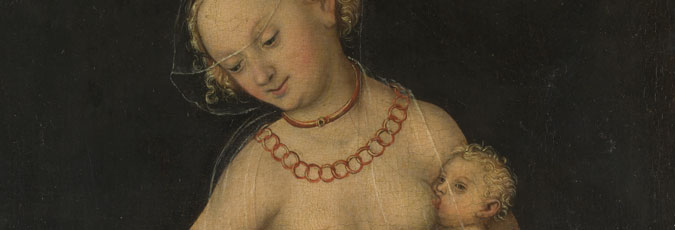Attribution and date
Attribution
Cranach listed two paintings with the subject of Charity in the account of his work made at Augsburg in 1552, but neither of these can be identical with the National Gallery picture as they are described as being on canvas.15 While little of the original background or foreground of this painting appears to remain intact, the figures have been retouched and the flesh paint is rubbed, the quality of the faces in particular is high, the hair is delicately depicted (although some of the girl’s hair extends over the repainted background and is not original), and the expressions are particularly tender and affectionate. The painting has rightly been accepted as the work of Lucas Cranach the Elder, despite its condition.
Date
Dendrochronological analysis provides a terminus post quem of 1533 and suggests a dating of or around 1534 (although it was only possible to derive a date from one of the two boards used for the panel). The earliest recorded dated paintings of Charity by Cranach are those of 1529, 1530, 1534 and 1535. The painting dated 1534 (Schaffhausen, Museum zu Allerheiligen, Sturzenegger Stiftung) similarly includes a girl with a doll on the left, a boy on the right and another clambering to embrace the mother suckling her baby; although the mother is seated, the children in this version closely resemble those in the National Gallery picture. Although NG2925 bears the form of the winged serpent device which indicates a date after 1537, this has been altered and may not be reliable; moreover, the congruence between the device and this date is not absolute in Cranach’s work. The form of the transparent veil over Charity’s head is seen only in paintings datable to after 1535. This work is most likely to date from the mid- to late 1530s, or even the early 1540s.
Further sections
16. Levey 1959, p. 21; Friedländer and Rosenberg 1978, no. 405.
17. Levey 1959, p. 12 noted the suggestion made in the 1929 catalogue that the National Gallery picture might date from about 1550; this was presumably derived from the date of the Augsburg list but, as mentioned above, the pictures listed in it were painted on canvas, which excludes the possibility that NG 2925 could have been one of them.
18. Koepplin 2007–8, fig. 1 (see note 4 above); Friedländer and Rosenberg 1978, no. 223.
19. Heydenreich 2007, pp. 293–5, esp. p. 293 and note 15 on p. 360. However, Gunnar Heydenreich has kindly pointed out the similarity of the serpent insignia to two post-1537 instances, namely the Suicide of Lucretia, Kunstsammlungen der Veste Coburg (Friedländer and Rosenberg 1978, no. 358D) and Judith with the Head of Holofernes, Staatliches Museum, Schwerin (Friedländer and Rosenberg 1978, no. 359B).
20. Comparing serpent insignia; I am grateful to Gunnar Heydenreich for this observation.

